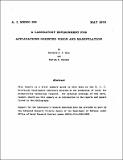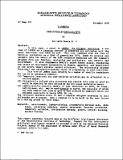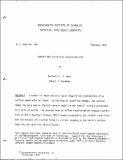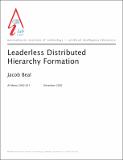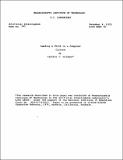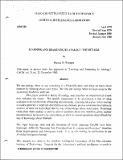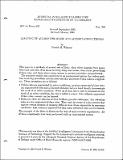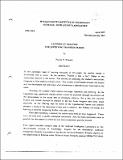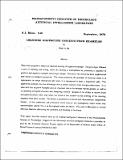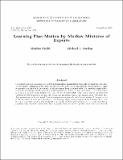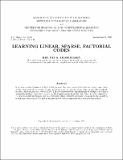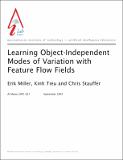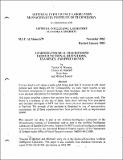Browsing AI Memos (1959 - 2004) by Title
Now showing items 525-544 of 1217
-
A Laboratory Environment for Applications Oriented Vision and Manipulation
(1976-05-01)This report is a brief summary guide to work done in the M.I.T. Artificial Intelligence Laboratory directed at the production of tools for productivity technology research. For detailed coverage of the work, readers ... -
LAMBDA: The Ultimate Declarative
(1976-11-01)In this paper, a sequel to "LAMBDA: The U ltimate Imperative", a new view of LAMBDA as a renaming operator is presented and contrasted with the usual functional view taken by L ISP. This view, combined with the view of ... -
Lambda: The Ultimate Imperative
(1976-03-01)We demonstrate how to model the following common programmingsconstructs in terms of an applicative order language similar to LISP: Simple Recursion, Iteration, Compound Statements and Expressions, GO TO and Assignment, ... -
LANDSAT MSS Coordinate Transformations
(1978-02-01)A number of image analysis tasks require the registration of a surface model with an image. In the case of satellite images, the surface model may be a map or digital terrain model in the form of surface elevations on ... -
Leaderless Distributed Hierarchy Formation
(2002-12-01)I present a system for robust leaderless organization of an amorphous network into hierarchical clusters. This system, which assumes that nodes are spatially embedded and can only talk to neighbors within a given radius, ... -
Leading a Child to a Computer Culture
(1975-12-01)"LOGO" is sometimes used as the name of a programming language. It is also used as the name of...what shall I call it?... an environment, a culture, a way of thinking about computers and about learning and about putting ... -
Learning a Color Algorithm from Examples
(1987-06-01)We show that a color algorithm capable of separating illumination from reflectance in a Mondrian world can be learned from a set of examples. The learned algorithm is equivalent to filtering the image data---in which ... -
Learning and Reasoning by Analogy: The Details
(1979-04-01)We use analogy when we say something is a Cinderella story and when we learn about resistors by thinking about water pipes. We also use analogy when we learn subjects like Economics, Medicine and Law. This paper ... -
Learning by Augmenting Rules and Accumulating Censors
(1982-05-01)This paper is a synthesis of several sets of ideas: ideas about learning from precedents and exercises, ideas about learning using near misses, ideas about generalizing if-then rules, and ideas about using censors to ... -
Learning by Creating and Justifying Transfer Frames
(1978-01-01)In the particular kind of learning discussed in this paper, the teacher names a destination and a source. In the sentence, "Robbie is like a fox," Robbie is the destination and fox is the source. The student, on analyzing ... -
Learning by Creating and Justifying Transfer Frames
(1977-01-01)Learning is defined to be the computation done by a student when there is a transfer of information to him from a teacher. In the particular kind of learning discussed, the teacher names a source and destination. In ... -
Learning Classes Correlated to a Hierarchy
(2003-05-01)Trees are a common way of organizing large amounts of information by placing items with similar characteristics near one another in the tree. We introduce a classification problem where a given tree structure gives us ... -
Learning Disjunctive Concepts From Examples
(1979-09-01)This work proposes a theory for machine learning of disjunctive concepts. The paradigm followed is one of teaching and testing, where the teaching is accomplished by presenting a sequence of positive and negative ... -
Learning Fine Motion by Markov Mixtures of Experts
(1995-11-01)Compliant control is a standard method for performing fine manipulation tasks, like grasping and assembly, but it requires estimation of the state of contact between the robot arm and the objects involved. Here we present ... -
Learning from Incomplete Data
(1995-01-24)Real-world learning tasks often involve high-dimensional data sets with complex patterns of missing features. In this paper we review the problem of learning from incomplete data from two statistical perspectives---the ... -
Learning Linear, Sparse, Factorial Codes
(1996-12-01)In previous work (Olshausen & Field 1996), an algorithm was described for learning linear sparse codes which, when trained on natural images, produces a set of basis functions that are spatially localized, oriented, ... -
Learning New Principles from Precedents and Exercises: The Details
(1981-11-01)Much Learning is done by way of studying precedents and exercises. A teacher supplies a story, gives a problem, and expects a student both to solve a problem and to discover a principle. The student must find the ... -
Learning object segmentation from video data
(2003-09-08)This memo describes the initial results of a project to create a self-supervised algorithm for learning object segmentation from video data. Developmental psychology and computational experience have demonstrated that the ... -
Learning Object-Independent Modes of Variation with Feature Flow Fields
(2001-09-01)We present a unifying framework in which "object-independent" modes of variation are learned from continuous-time data such as video sequences. These modes of variation can be used as "generators" to produce a manifold of ... -
Learning Physical Descriptions from Functional Definitions, Examples, and Precedents
(1982-11-01)It is too hard to tell vision systems what things look like. It is easier to talk about purpose and what things are for. Consequently, we want vision systems to use functional descriptions to identify things when ...
